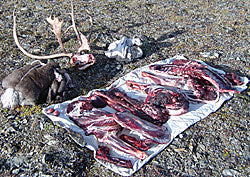Anyone who has ever harvested a big game animal has felt the exhilaration of fulfilling that dream and seeing their patience and hard work pay off. People exchange high fives, take pictures and nothing else in the world matters in that moment.
Then the thrill of the kill gets interrupted by a whopping realization. How are you going to get that burly animal out of the unforgiving mountains and into the protection of your deep freeze? Suppose a heat wave causes temperatures to soar during your hunt. Suppose you have an elk carcass on your hands in wolf country.
Meat Preservation is Key
Successful hunts require meticulous planning, preparation and, above all, determination. One of the most important things to consider is the type of terrain you will be hunting in. Other than that, consider what methods you will utilize in preserving the hundreds of pounds of big game meat you just accumulated. Meat preservation is key. If you don’t have a plan to get your game meat from the field to the deep freeze, then stay home.
Here are some good reminders on how to preserve your meat while in the field. They will help you return home with several years worth of unspoiled meat that’s ready to go on the grill or in your Bradley smoker.
How to Preserve Wild Game Meat in the Field
Before we get into the nitty gritty, let’s talk really quick about shot placement. It’s imperative that you hit vitals, bringing down your big game animal quickly. Not only will this save you loads of time and effort, but it will help preserve the good flavour and texture of the meat.
When an excited animal exerts itself for long periods of time prior to dying, lactic acid levels are higher in the meat. This gives it an off flavour and texture. Likewise, a gut shot will contaminate the meat. Clean kills are key.
-
Cool immediately – As soon as you kill the animal, find a way to reduce the temperature of the meat to avoid bacteria growth. You have less than an hour to take pictures and properly field dress your kill. Otherwise, bacteria will begin multiplying like crazy, especially on a hot day. Finding a cool stream nearby and submersing your kill in it for an hour will buy you a lot of time. If there is no nearby water, skin and quarter off sections of the meat and hang them in some shade. If you’re hunting in 40-70°F weather, the task of keeping your meat cool is greatly facilitated.
-
Keep dry – Bacteria loves warmth and moisture. After you have brought the temperature of the meat down at least 30 degrees or so, the object is to keep the meat dry. If water is needed to further cool the meat, wipe it down and let it air dry.
-
Keep clean – Flies, humidity and sunlight are your worst enemies in the field. In warm weather, bag meat immediately in a breathable material, such as cheesecloth, to keep off dirt and flies. Synthetic blend bags are a better fly-proof solution, as blowflies can actually blow eggs through cheesecloth bags. In cold weather, keep the hide on the animal so the meat is unexposed.
Hunts vary a great deal from place to place. So, above all, plan ahead of time so you are well prepared for the work following a successful kill. Bringing the right equipment for preserving your meat is just as important as bringing your rifle.
When nature throws you a curve ball, or if you have to track down a wounded animal for miles, remind yourself that having a deep freezer full of tasty wild game meat will make every ounce of work you put into preserving the meat worth it!
If you have additional preservation tips, please leave a comment!





